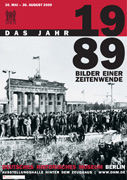


Exhibition | Heavy Times | Peaceful Revolution | International Politics | West Looks East
Signs of destabilization in the Eastern Bloc began to increase in the mid-eighties. After Mikhail Gorbachev had abandoned the Soviet Union’s claim to hegemony in favour of the autonomy and sovereignty of the allied states, Hungary and Poland began introducing democratic reforms under pressure from their societies. The waves of people fleeing or emigrating from the GDR after the opening of the Hungarian frontier and finally the fall of the Berlin Wall placed the German question once more on the international political agenda.
The victorious powers of the Second World War were suddenly confronted with the possibility of a unification of the two German states and thus a restructuring of the post-war European political order. France and Great Britain first met the idea of a united Germany with scepticism; the USA welcomed it as the fulfilment of a long-term aim of Western politics, while the Soviet Union signalled their approval in February 1990.
In the so-called Two-plus-Four talks the two German states, in cooperation with representatives of the Four Powers, regulated such fundamental foreign-policy questions as the alliance to which a united Germany would be affiliated, its sovereignty and its integration into Europe.
